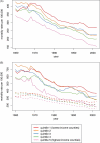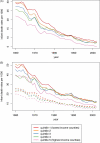The fall and rise of US inequities in premature mortality: 1960-2002
- PMID: 18303941
- PMCID: PMC2253609
- DOI: 10.1371/journal.pmed.0050046
The fall and rise of US inequities in premature mortality: 1960-2002
Abstract
Background: Debates exist as to whether, as overall population health improves, the absolute and relative magnitude of income- and race/ethnicity-related health disparities necessarily increase-or decrease. We accordingly decided to test the hypothesis that health inequities widen-or shrink-in a context of declining mortality rates, by examining annual US mortality data over a 42 year period.
Methods and findings: Using US county mortality data from 1960-2002 and county median family income data from the 1960-2000 decennial censuses, we analyzed the rates of premature mortality (deaths among persons under age 65) and infant death (deaths among persons under age 1) by quintiles of county median family income weighted by county population size. Between 1960 and 2002, as US premature mortality and infant death rates declined in all county income quintiles, socioeconomic and racial/ethnic inequities in premature mortality and infant death (both relative and absolute) shrank between 1966 and 1980, especially for US populations of color; thereafter, the relative health inequities widened and the absolute differences barely changed in magnitude. Had all persons experienced the same yearly age-specific premature mortality rates as the white population living in the highest income quintile, between 1960 and 2002, 14% of the white premature deaths and 30% of the premature deaths among populations of color would not have occurred.
Conclusions: The observed trends refute arguments that health inequities inevitably widen-or shrink-as population health improves. Instead, the magnitude of health inequalities can fall or rise; it is our job to understand why.
Conflict of interest statement
Figures



References
-
- Phelan JC, Link BG. Controlling disease and creating disparities: a fundamental cause perspective. J Gerontol Series B. 2005;60B(Special Issue II):27–33. - PubMed
-
- Cutler D, Deaton A, Lleras-Muney A. The determinants of mortality. J Economic Perspectives. 2006;20:97–120.
-
- Mechanic D. Policy challenges in addressing racial disparities and improving population health. Health Affairs. 2005;24:335–338. - PubMed
-
- Siddiqi A, Hertzman C. Towards an epidemiological understanding of the effects of long-term institutional changes on population health: a case study of Canada versus the USA. Soc Sci Med. 2007;64:589–603. - PubMed
-
- Kunitz S. The health of populations: General theories and particular realities. Oxford: Oxford University Press; 2006.
Publication types
MeSH terms
LinkOut - more resources
Full Text Sources
Other Literature Sources

